headlights AUDI A3 2012 Owner´s Manual
[x] Cancel search | Manufacturer: AUDI, Model Year: 2012, Model line: A3, Model: AUDI A3 2012Pages: 280, PDF Size: 70.11 MB
Page 91 of 280
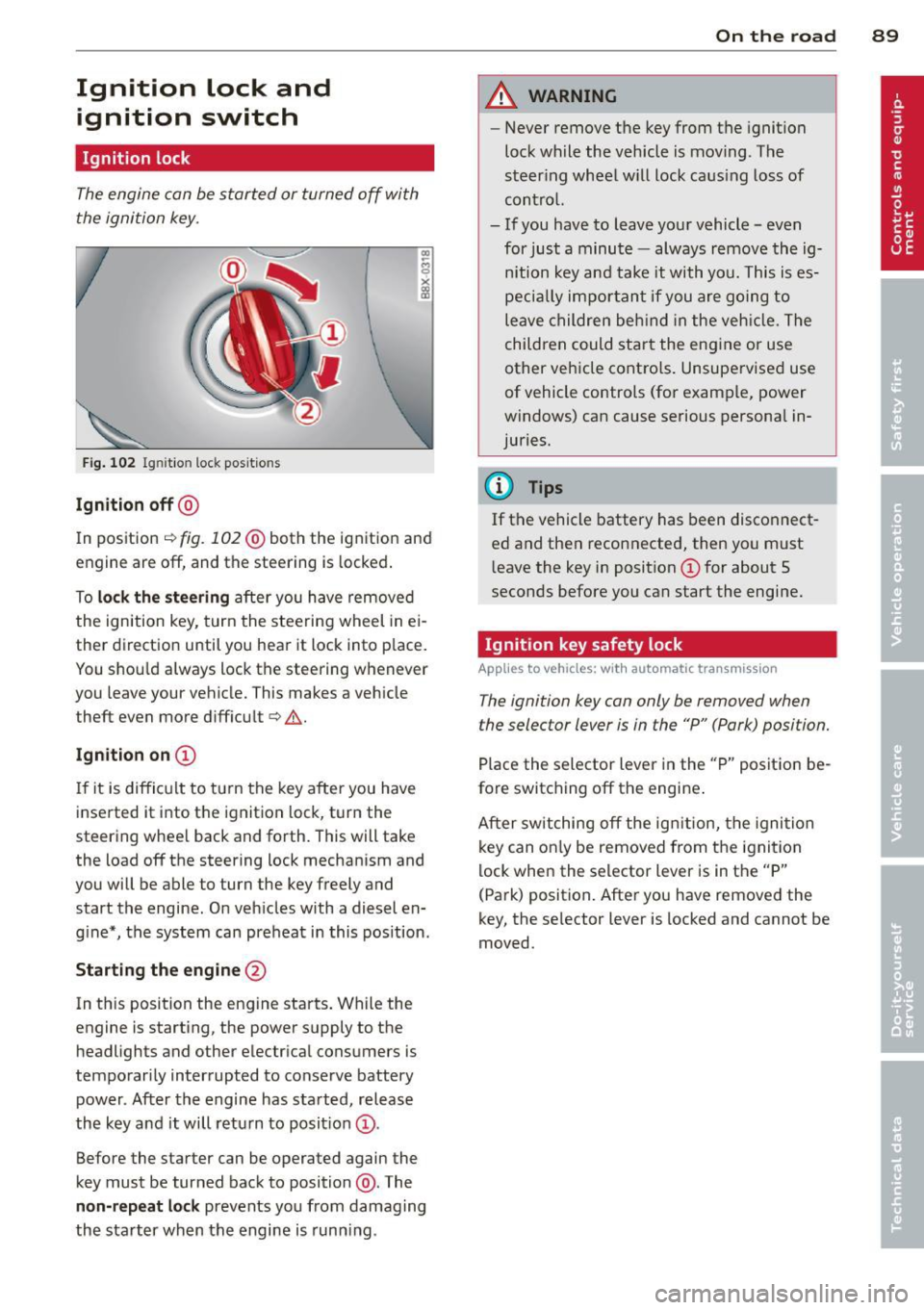
Ignition lock and ignition switch
Ignition lock
The engine can be started or turned off with
the ignition key.
Fig. 102 I gni tion lock positio ns
Ignition off@
In position ¢ fig. 102@both the ignition and
engine are off, and the steering is locked.
To
lock the steering after you have removed
the ignition key, turn the steering wheel in ei
ther direction until you hear it lock into place.
You shou ld always lock the steering whenever
you leave your vehicle. This makes a vehicle
theft even more difficul t
q ,&.
Ignition on CD
If it is difficult to turn the key after you have
inserted it into the ignition lock, turn the
steering wheel back and forth. This will take
the load off the steering lock mechan ism and
you will be able to turn the key freely and
start the engine. On vehicles with a diesel en
g ine*, the system can preheat in this pos ition .
Starting the engine @
In this position the engine starts. While the
engine is starting, the power supply to the
headlights and other electrical consumers is
temporarily interrupted to conserve battery power. After the engine has started, release
the key and it will return to position @.
Before the starter can be operated again the
key must be turned back to position @. The
non-repeat lock prevents you from damag ing
the starter when the engine is running.
On the road 89
A WARNING
-Never remove the key from the ignition
lock wh ile the vehicle is moving. The
steering wheel will lock caus ing loss of
control.
- If you have to leave your vehicle - even
for just a minute -always remove the ig
nition key and take it with you. This is es
pecia lly important if you are going to
leave children behind in the vehicle. The
children could start the engine or use
other vehicle controls. Unsupervised use
of vehicle controls (for example, power
windows) can cause serious personal in
juries.
(D Tips
If the vehicle battery has been disconnect
ed and then reconnected, then you must leave the key in position @for about 5
seconds before you can start the engine.
Ignition key safety lock
Applies to vehicles: wit h automatic transmission
The ignition key can only be removed when
the selector lever is in the "P" (Park) position.
Place the selector lever in the "P" position be
fore switching off the engine .
After switching off the ign ition, the ignition
key can on ly be removed from the ignition
lock when the selector lever is in the "P"
(Park) position. After you have removed the
key, the se lector lever is locked and cannot be
moved.
Page 176 of 280
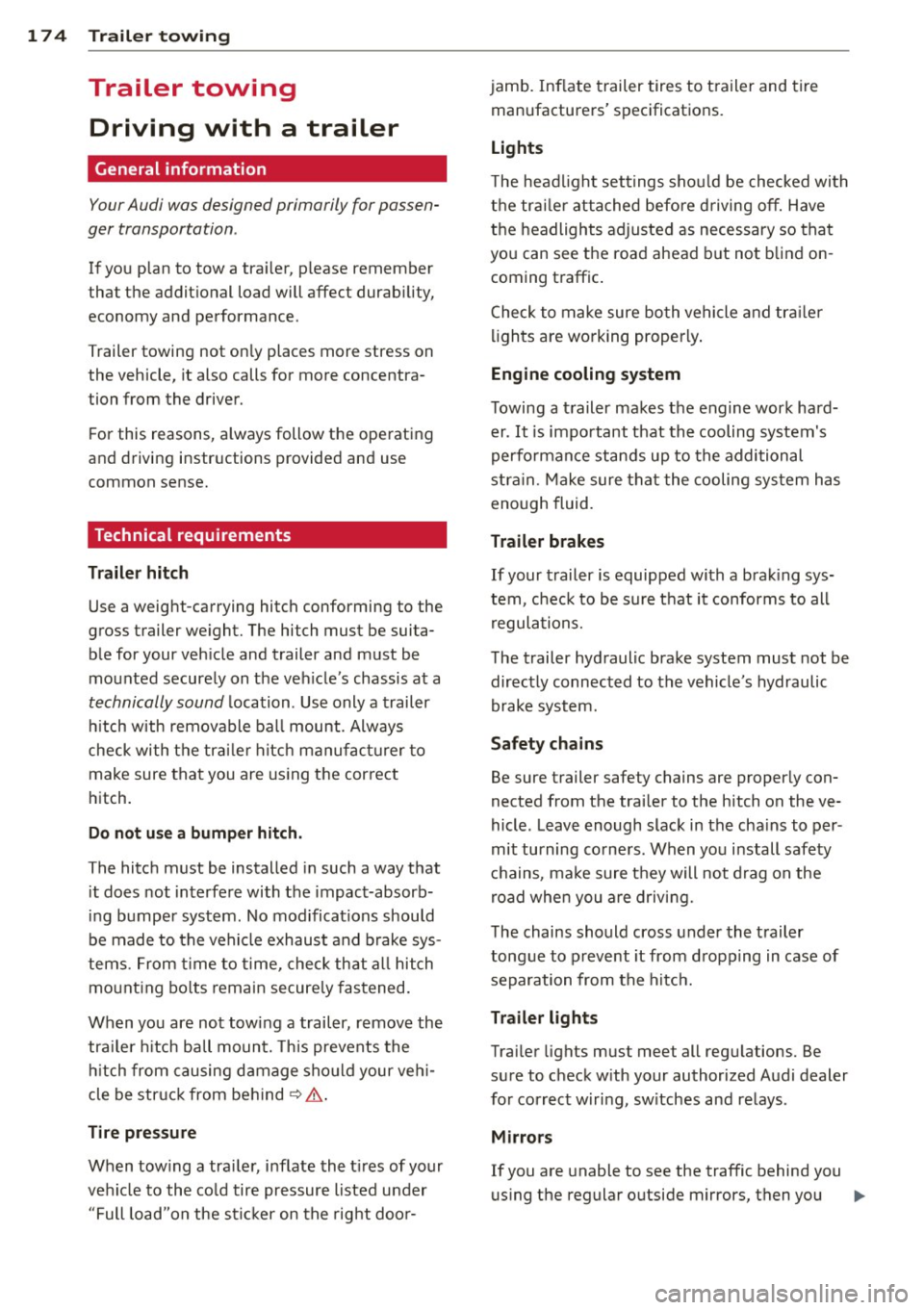
174 Trailer towing
Trailer towing Driving with a trailer
General information
Your Audi was designed primarily for passen
ger transportation .
If you plan to tow a tra iler, p lease remember
that the addit ional load will affect durability,
economy and performance.
T railer towing not on ly places more stress on
the vehicle, it also calls for more concentra
tion from the driver.
F or this reasons, always follow the operating
and drivi ng in str uctions provided and use
common sense.
Technical requirements
Traile r hitch
Use a weight-carrying hitch conforming to the
gross trailer weight. The hitch must be suita
b le for your veh icle and trailer and must be
mounted securely on the ve hicle's chassis at a
technically sound location. Use only a trailer
h itch with removable ba ll mount. Always
check with the tr ailer hitch manufac turer to
make sure tha t you are using t he cor rect
hitch.
Do not us e a bumper hitch .
The hitch must be installed in such a way that
it does not interfere with the impact-absorb
ing bumper syst em. No modifications should
be made to the vehi cle exhaust and brake sys
tems. From time to time, check th at a ll hitch
mo unt ing bo lts remain securely fastened.
When you are not towing a trailer, remove the
tra iler hitch ball mount. This prevents the
h itch from causing damage sho uld your ve hi
cle be str uck from behind
¢ A .
Tire pressure
When tow ing a traile r, inflate the t ires of your
ve hicle to the co ld tire pressure listed under
"Full load"on the stick er on the rig ht doo r- jamb. Inflate trailer tires to trailer and tire
manufacturers' specifications.
Lights
T he headlight set tings sho uld be checked with
t h e trai le r attached before d riving o ff. Have
the headlights adjusted as necessary so tha t
yo u can see t he road ahead b ut not blind on
coming traffic.
Check to make sure bo th ve hicle and tr ailer
lights are wo rk ing properly .
Engine cooling system
T owing a t railer makes the engine work hard
er.
It i s impo rtant that the cooling system's
performance stands up to the additional
stra in. Make sure tha t the cooling sys tem has
enough fluid.
Trailer brakes
If your trailer is equipped with a brak ing sys
tem, c heck to be sure t hat it conforms to all
regula tions.
The trailer hyd raulic brake system must not be
directly connected to the vehicle's hydraulic
brake system.
Safety ch ains
Be sure trailer safety chains are properly con
nected from the trailer to the hitch on the ve
hicle. Leave enough slack in the cha ins to per
mit turning co rne rs. When yo u in stall safety
c h ains, ma ke sure they will not drag on the
r oad when you a re driving.
The chains should cross under the t railer
tong ue to prevent it from dropping in case of
separation from the h itch.
Trailer lights
Trai ler lights must meet all regulations. Be
sure to check w ith your authorized Audi dealer
for correct w ir in g, sw itches and re lays .
Mir rors
If you are unable to see the traffic behind you
us ing the regular outside mirrors, then you
Page 181 of 280

CD Note
You should remove debris (such as insects)
from the headlight lenses on a regular basis, for example when refueling your vehi
cle. Never clean the headlights with a dry
cloth or sponge . Use a wet cloth or
sponge.
It is best to use soapy water .
Automatic car wash
The vehicle can be washed in almos t any
modern automatic car wash .
The vehicle paint is so durable that the vehicle
can normally be washed without problems in
an automatic car wash . However, the effect on
the paint depends to a large extent on the de
sign of the facility, the filtering of the wash
water , the type of wash and care material , etc .
If the paint has a dull appearance after going
through the car wash or is scratched, bring
this to the attention of the operator immedi
ately. If necessary, use a different car wash.
Before going through a car wash, be sure to
take the usual precautions such as closing the
windows and panoramic sliding sunroof*. Re move antenna if applicable.
If you have installed additional accessories on
the vehicle -such as spoilers, roof rack, etc. -
it is best to ask the car wash operator if these
should be removed.
A WARNING
Always read and heed all WARNINGS and other information
¢ page 178.
Washing the vehicle by hand
A lot of water is needed when washing a vehi
cle by hand.
11-Before you start washing, make sure you
have read and understood the WARNINGS
¢ A in General information on page 178.
11-First soak all dried dirt until it is soft, then
rinse it off .
11-As you clean your vehicle, s tart with the
roof and work your way down to the bottom,
Cleaning and protection 179
using a sponge, a sponge glove or a clean
brush.
"" Rinse the sponge or the sponge glove often,
flushing it clean each time.
11-Use special car shampoo only for very per
sistent dirt .
11-Rinse the car thoroughly with water .
11-Use a chamois leather to gently wipe the ex-
terior dry.
Use a separate sponge for cleaning the
wheels, door sills and other regions exposed
to road dirt. In this way, you will not scratch
the paint with coarse particles imbedded in
the sponge the next time you wash the car.
A WARNING
= -
-Do not clean the underside of the chas-
sis, fenders, wheel covers , or other hard
to reach parts without protecting your hands and arms . You may cut yourself on
sharp-edged metal parts.
- Always read and heed all WARNINGS and
other information
¢ page 178.
CD Note
- Never try to remove dirt, mud or dust if
the surface of the vehicle is dry. Never
use a dry cloth or sponge, since this
could scratch your vehicle's paint or win
dows.
- Never wash your car in bright sunlight.
Drops of water act as magnifying lenses
and may damage your paint .
- When you wash your car in the winter: if
you rinse your vehicle with a hose, be
careful not to aim the stream of water
directly at locks, or at door or hatch
openings -they can freeze shut.
- Never use sponges designed to remove
insects, or any kitchen scouring sponges
or similar products. They can damage
your paint finish.
- Never use a dry cloth or sponge to clean
the headlights. Only use wet cloths or
sponges to prevent scratches. It is best
to use soapy water. •
•
Page 182 of 280
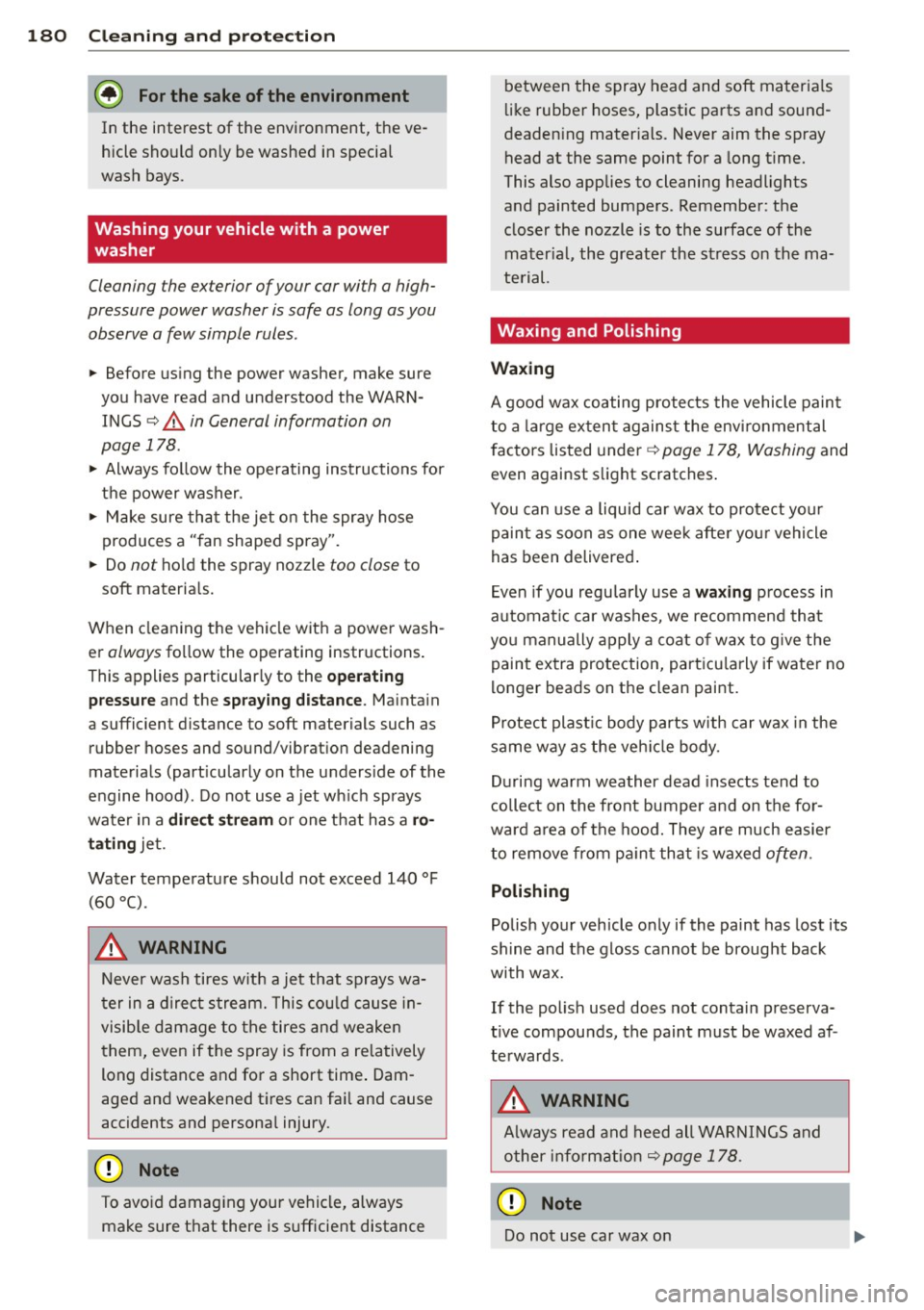
180 Cleaning and protection
@ For the sake of the environment
In the interest of the environment, the ve
hicle should on ly be washed in special
wash bays.
Washing your vehicle with a power
washer
Cleaning the exterior of your car with a high
pressure power washer is safe as long as you
observe a few simple rules .
~ Before using the power washer, make sure
you have read and understood the WARN
INGS
c::> A in General information on
page 178 .
~ Always fo llow the operating instructions for
the power washer.
~ Make sure tha t the jet o n the spray hose
produces a "fan shaped spray".
~ Do not ho ld the spray nozzle too close to
soft materia ls.
When clean ing the veh icle wit h a power wash
er
always fo llow the operating instructions .
This applies particularly to the
oper ating
pressu re
and the sp ray ing distance . Maintain
a sufficient distance to soft materials such as
rubber hoses and sound/vibrat io n deadening
materials (part icularly on the underside of the
engine hood). Do not use a jet wh ich sprays
water in a
dire ct stream or one that has a ro
ta ting
jet.
Water temperature should not exceed 140 °F
(60 °().
A WARNING
Never wash tires w it h a je t that sprays wa
t er in a direc t stream. This cou ld cause in
visib le damage to the tires and weake n
t hem, even if the spray is from a re latively
long distance and for a short time . Dam
aged and weakened t ires can fa il and cause
accidents and persona l injury.
([) Note
To avo id damag ing your vehicle, always
make sure t hat there is sufficient distance between the spray head and soft materia
ls
li ke rubber hoses, plastic parts and sound
deaden ing mater ials. Never aim the spray
head at the same point for a long time.
This also applies to cleaning headlights
and painted bumpers. Remember: the
closer the nozzle is to the surface of the
mater ia l, the greater the stress on the ma
te rial.
Waxing and Polishing
Waxing
A good wax coating protects the vehicle pain t
to a la rge ex ten t agains t the envi ronmental
f actors lis ted under
c::> page 178, Washing and
even against sli ght scratches .
You can use a liquid car wax to prote ct yo ur
paint as soon as one wee k afte r you r vehicle
has been delivered .
E ven if you regu larly use a
wa xing p rocess in
a ut oma tic car washes, we recommend tha t
yo u manually apply a coat o f wax to g ive the
paint extra protection, part icu larly if water no
l onger beads on t he clean paint.
Protect plast ic body parts with car wax in the
same w ay as the veh icle body.
D ur ing warm weather dead insects tend to
collect on the front bumper and on the fo r
wa rd area of the hood. They are much easier
to remove from p aint th at is waxed
often.
Polishing
Polish your vehicle only if the paint has lost its
sh ine and the gloss cannot be broug ht back
with wax.
If the polish used does not contain preserva
t ive compou nds, the paint must be waxed af
te rwards .
A WARNING
Always read and heed all WARNI NGS and
other info rmation
c::> page 178 .
(D Note
Do not use car wax on
Page 246 of 280
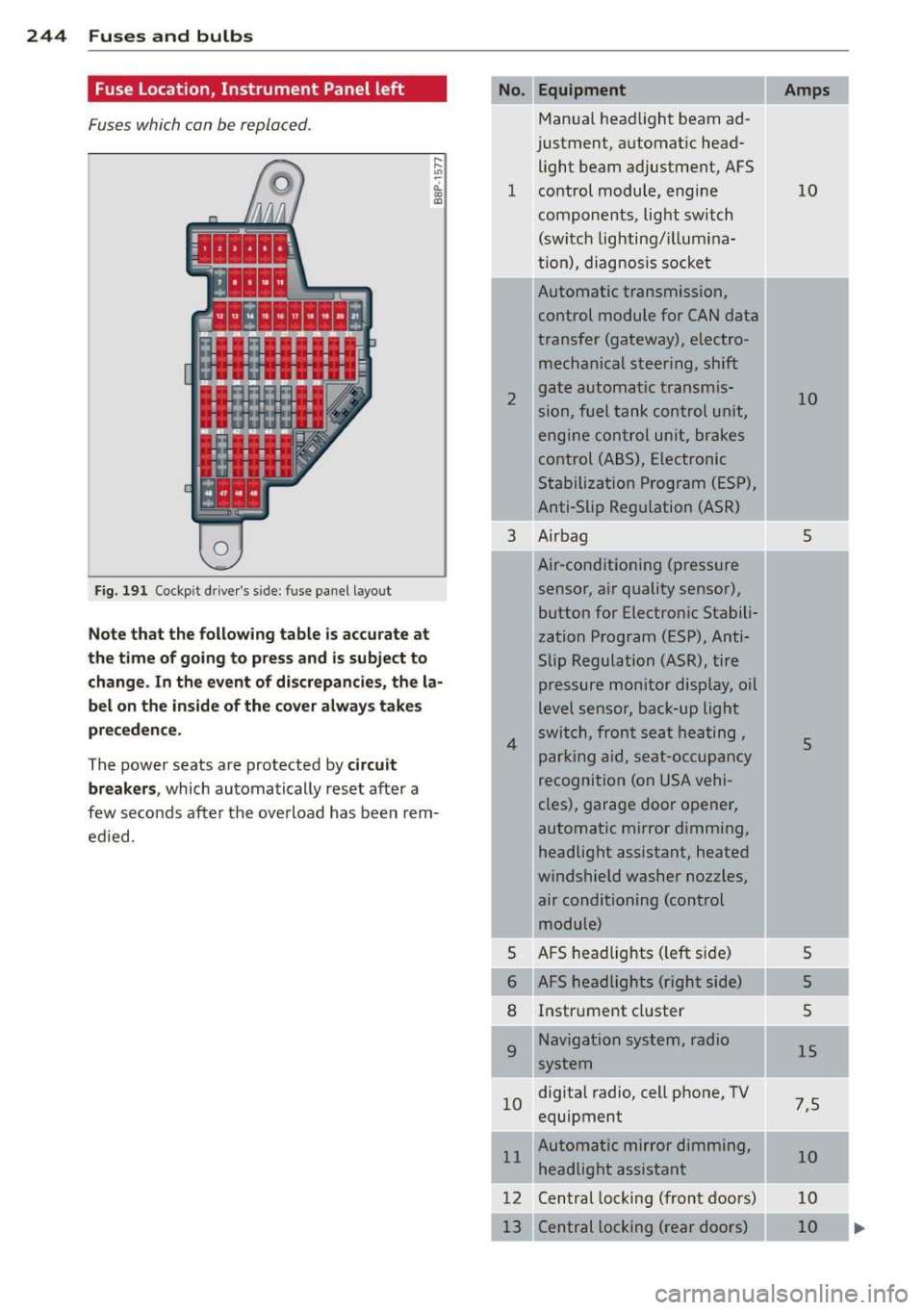
244 Fuses and bulbs
Fuse Location, Instrument Panel left
Fuses which can be replaced.
Fig. 191 Cockp it driver 's s ide: fuse pane l layout
Note that the following table is accurate at
the time of going to pr ess and i s subject to
change . In the event of d iscrepancies, the la
bel on the in side of the cover always take s
pr eceden ce .
The power seats are protected by circuit
break ers,
which automatically reset after a
few seconds after the ove rload has been rem
ed ied .
Equipment
Manua l head light beam ad
justment, a utomat ic head
light beam adjustment, AFS
1 co ntrol m odule, engine
components, light switch
(switch lighting/illumina
ti on), diagnosis socke t
2
3
4
5
6
8
9
Automatic transmission,
control module for CAN data
transfer (gateway), electro
mechanical steering, shift
gate automatic transmis
sion, fuel tank control unit,
engine control unit, brakes
control (A BS), Electronic
Stabili zation Program (ESP) ,
Anti-Slip Regulation (ASR)
Air bag
Air-conditioning (pressure
sensor, air quality sensor), button for Electronic Stabili
zation Program (ESP), Anti
Slip Regulat ion
(ASR), tire
pressure monitor display, oil
level senso r, back-up ligh t
s w itch, front se at he ati ng ,
p ark ing aid, sea t-occupancy
recognition (on USA vehi
cles), garage door opener,
automa tic mirror dimming,
headlight assistant, heated
windshield washer nozzles, air conditioning (control
module)
AFS headlights ( left si de)
AFS headlights (right side) Instr ument cluster
Navigation system, radio
system
1 0 digital
radio, cell phone, TV
equipment
11 Automatic mirror dimming,
headlight assistant
12 Central lock ing (front doors)
Central locking ( rear doors)
Amps
10
10
5
5
5
5
5
15
7 ,5
10
10
10
Page 271 of 280
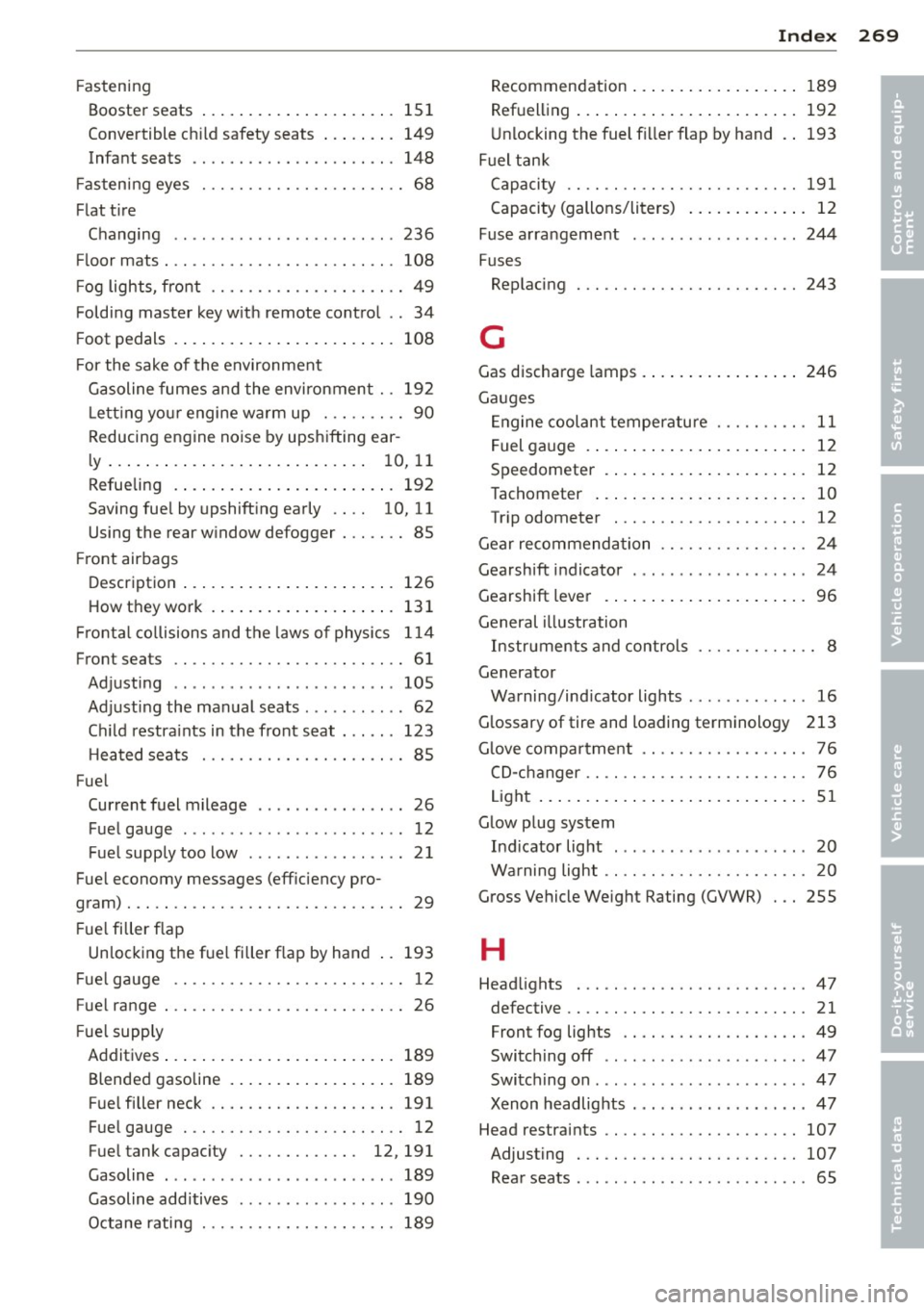
Fastening
Booster seats .... ..... ... .. .. .. ... 151
Convertible ch ild safety seats ... .. .. . 149
Infant seat s ............. .... .. ... 148
F astening eyes . . . . . . . . . . . . . . . . . . . . . . 68
Flat t ire
Changing .. ................ ... ... 236
F loor mats . .. ............. .... .. ... 108
F og lights, fro nt ........... .... .. .. .. 49
Folding master key w ith remote contro l . . 34
F oot pedals . ... .... .... ... .. .. .. ... 108
F or the sake of the environment
Gasoline fumes and the envi ronment . . 19 2
L e tting you r engine w arm up . .. .. .. .. 90
Reducing engine noise by upsh ifting ear -
ly . . . . . . . . . . . . . . . . . . . . . . . . . . . . 1 0, 11
Refueling . . . . . . . . . . . . . . . . . . . . . . . . 192
Saving fue l by upshift ing early . . . . 10, 11
Using the rear w indow defogger . .. .. .. 85
Fr ont airbags
Descr ipt ion .... .. ..... ... .. .. .. ... 126
How they work . . . . . . . . . . . . . . . . . . . . 131
Fr onta l co llisions and t he laws of physics 1 14
Front seats .. ............. .... .. .... 61
Adjusting .. ................ ... ... 105
Adjust ing the manual seats . .. .. .. .. .. 62
C hi ld restra ints in the front seat . .. .. . 123
H eated seats . . . . . . . . . . . . . . . . . . . . . . 85
Fue l
Current fuel mileage . . . . . . . . . . . . . . . . 26
F uel gauge .... .. .. ...... .. .. .. .. .. 12
Fue l supp ly too low . . . . . . . . . . . . . . . . . 2 1
Fue l economy messages (eff iciency pro-
gram) . .... .. .. ............. .. .. .... 29
F ue l filler f lap
Un lock ing the fue l filler f lap by hand .. 193
F ue l gauge . . . . . . . . . . . . . . . . . . . . . . . . . 12
Fue l range . . . . . . . . . . . . . . . . . . . . . . . . . . 26
F ue l supp ly
A dditives . . . . . . . . . . . . . . . . . . . . . . . . . 189
Blended gasoline . ..... ... .. .. .. .. . 189
F ue l filler neck ........... .... .. .. . 191
Fue l gauge . ............. .... .. .... 12
Fue l tank capac ity . . . . . . . . . . . . . 12, 191
Gasoline . ............ ...... .... .. 189
Gasoline additives . ....... .. .. .. .. . 190
Octane rating ............ .... .. .. . 189
Inde x 269
Recommendation ... . .. ..... ... .. .. 189
Ref uell ing ... .. .... . ... ...... ... .. 192
U nlocking the fuel f iller flap by hand 193
Fuel tank Capaci ty .. .. .. .. ................. 191
Capacity (gallons/liters) . . . . . . . . . . . . . 12
Fuse a rra ngeme nt ................. . 244
Fuses Rep lacing . .. .. .. .. ............... 243
G
Gas discharge lamps . .. ... .... ... .. .. 246
Ga uges
E ngine cool ant tempe ratu re . . . . . . . . . . 11
F uel ga uge . . . . . . . . . . . . . . . . . . . . . . . . 12
Speedometer . . . . . . . . . . . . . . . . . . . . . . 12
Tachometer . . . . . . . . . . . . . . . . . . . . . . . 10
Tr ip odometer . .. ................. . 12
Gear recommend ation .. ......... .. .. . 24
Gearshift indicator ................. .. 24
Gearshift leve r .... .. . .. .. ..... ... .. . 96
General illustration
Instr uments and controls ....... .. .. .. 8
Generator Warning/ind icator lights ........... .. 16
G lossary of tire and loading terminology 213
G love compa rtme nt . . . . . . . . . . . . . . . . . . 76
CD-ch anger . . . . . . . . . . . . . . . . . . . . . . . . 76
Li ght ... .. .. .... .. . .. .. ..... ... .. . 51
G low plug system
Ind icator light .... ............... .. 20
Warning light .. .. ... ............ .. . 20
Gross Vehicle Weight Rating (GVWR) . .. 255
H
Head lights . .. .. .. ................. . 47
defective . . . . . . . . . . . . . . . . . . . . . . . . . . 21
Front fog lights .. .. ........... .... . 49
Switch ing off .. .. .. . .. .... .... .. .. . 47
Switching on ..... .. ..... ........... 47
Xenon headlights . .. . .. ....... ... .. . 4 7
Head restrai nts .. .. ................. 107
Adjusting ... .. ...... ............. 107
Rear seats . . . . . . . . . . . . . . . . . . . . . . . . . 65
•
•
Page 273 of 280
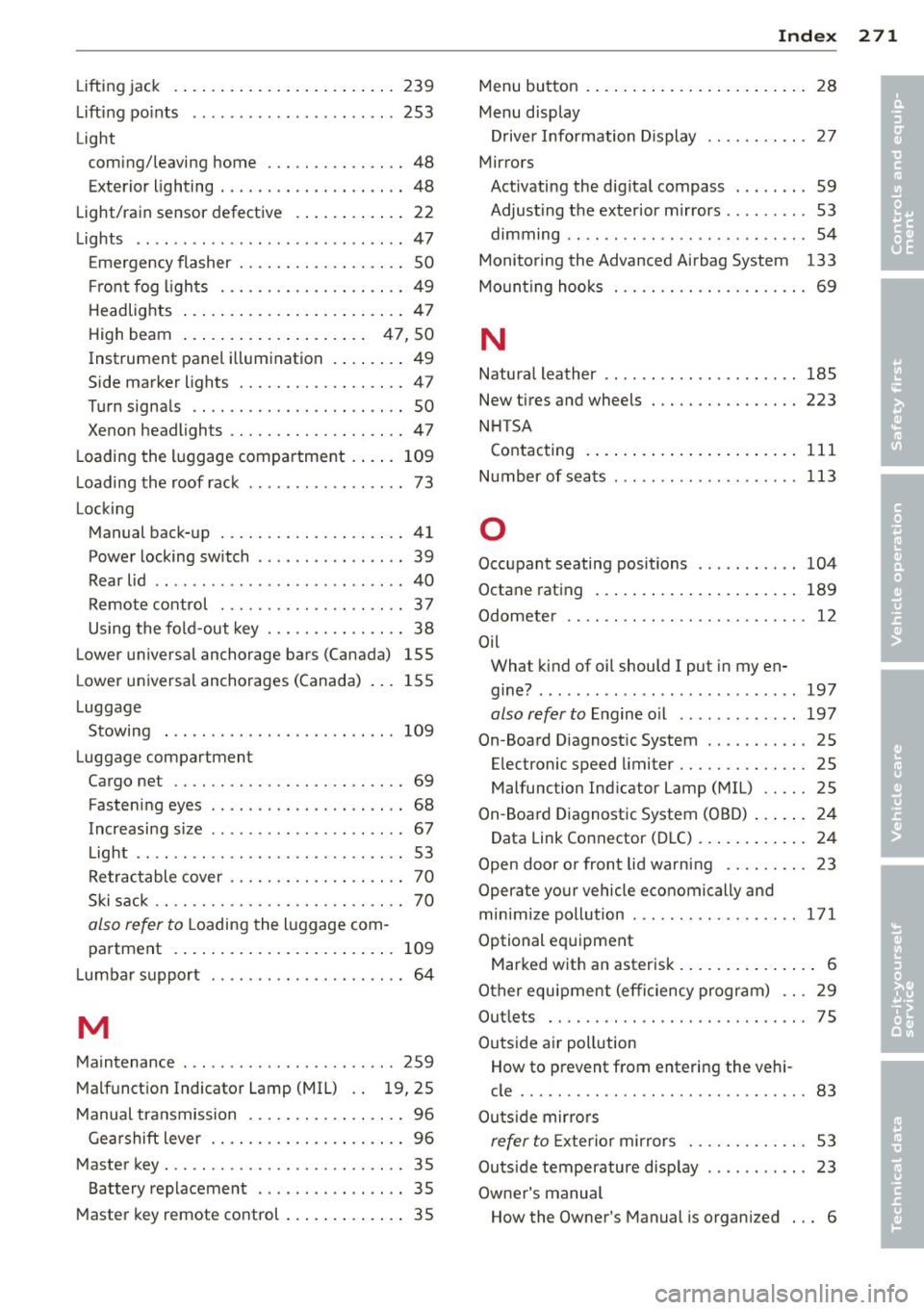
Lifting jack .... .... .... ... .. .. .. ... 239
Lifting po ints ...................... 253
Light coming/leaving home ............... 48
Exterior lighting .......... .......... 48
Light/ra in sensor defective . ... .. .. .. .. 22
Lights .. .. ..... ........... ...... ... 47
E mergency flasher . . . . . . . . . . . . . . . . . . SO
Fr ont fog l igh ts .......... .... .. .. .. 49
H eadlig hts ... .... .... ... .. .. .. .... 47
High beam . . . . . . . . . . . . . . . . . . . . 47, 50
Instrument panel i llum ination . ... .. .. 49
Side marker lights ........ ...... .... 47
Turn signals .. ........... .. .. .. .... 50
Xeno n headlights ................... 47
L oading the l uggage compartment . ... . 109
L oading the roof rack . . . . . . . . . . . . . . . . . 73
Locking Manual back-up .......... .. .. .. .. .. 41
Power locking switch . . . . . . . . . . . . . . . . 39
Rear lid .. ..... ........... ...... ... 40
Remote control . . . . . . . . . . . . . . . . . . . . 3 7
Using the fo ld-out key . . . . . . . . . . . . . . . 38
Lower universa l anchorage bars (Canada) 155
L ower universa l anchorages (Canada) 155
L uggage
Stowing . .. ..... ....... .... ... .. . 109
Luggage compartment
Cargo net .. ............. .... .. .... 69
Fasten ing eyes .................. ... 68
Increasing size ... .. ... ... .. .. .. .. .. 67
L ight . . . . . . . . . . . . . . . . . . . . . . . . . . . . . 53
Re tractable cover . . . . . . . . . . . . . . . . . . . 70
Ski sack . . . . . . . . . . . . . . . . . . . . . . . . . . . 70
also refer to Loading the l uggage com
partment . . . . . . . . . . . . . . . . . . . . . . . . 109
L umbar support ..................... 64
M
Maintenance ............... ...... .. 259
M alfunction Indicator Lamp (MIL) . . 1 9, 25
M anual tra nsmission ................. 96
G ea rshift lever ........... .. .. .. .. .. 96
Master key . ................ ...... ... 35
Battery replacement ................ 35
Master key remote control ... .. .. .. .. .. 35
Inde x 271
Menu bu tton . ..... .. . .. .. ..... ... .. . 28
Menu display Drive r Infor mation Display ........... 27
Mirrors Activating the dig ital compass ........ 59
Adjus ting the exterior m irrors . . . . . . . . . 53
dimming ........ .. ................ 54
Monitoring the Advanced Airbag System 133
Mo unti ng hoo ks . . . . . . . . . . . . . . . . . . . . . 69
N
Natura l leather .. .. .. ..... .......... 185
New t ires and wheels ................ 223
N HT SA
Co ntacting . ... .... . ... ...... ... .. 111
Number of sea ts ... .. ............... 113
0
Occupant seating positions .......... . 104
Octane rating ....... . .. .. ..... ... .. 189
Odometer . . . . . . . . . . . . . . . . . . . . . . . . . . 12
Oil Wha t kind of oil should I put in my en-
gine? ........ ... .. ............... 197
also refer to Engine o il ... ... ..... .. 197
On-Board D iagnost ic System ........... 25
E lectronic speed limiter .............. 2S
Malfunction Indicator Lamp (MIL) ..... 25
On-Boa rd Diagnostic System (OBD) ... .. . 24
Data Link Connector ( DLC) .... ... .. .. . 24
Open door o r fron t lid wa rn ing ......... 23
Operate your vehicle economically and
minimize pollution ... . .. .... ...... .. 171
Optional eq uipment
Marked with an asterisk . . . . . . . . . . . . . . . 6
O ther equ ipment (e fficiency program) ... 29
Out lets ............................ 75
Outside ai r poll ution
How to prevent from entering the vehi-
cle ............................... 83
Outs ide mir ro rs
refer to E xterio r mi rro rs . . . . . . . . . . . . . 53
Outs ide temperature disp lay ......... .. 23
Owner's manual How the Owner 's Manual is organ ized ... 6
•
•